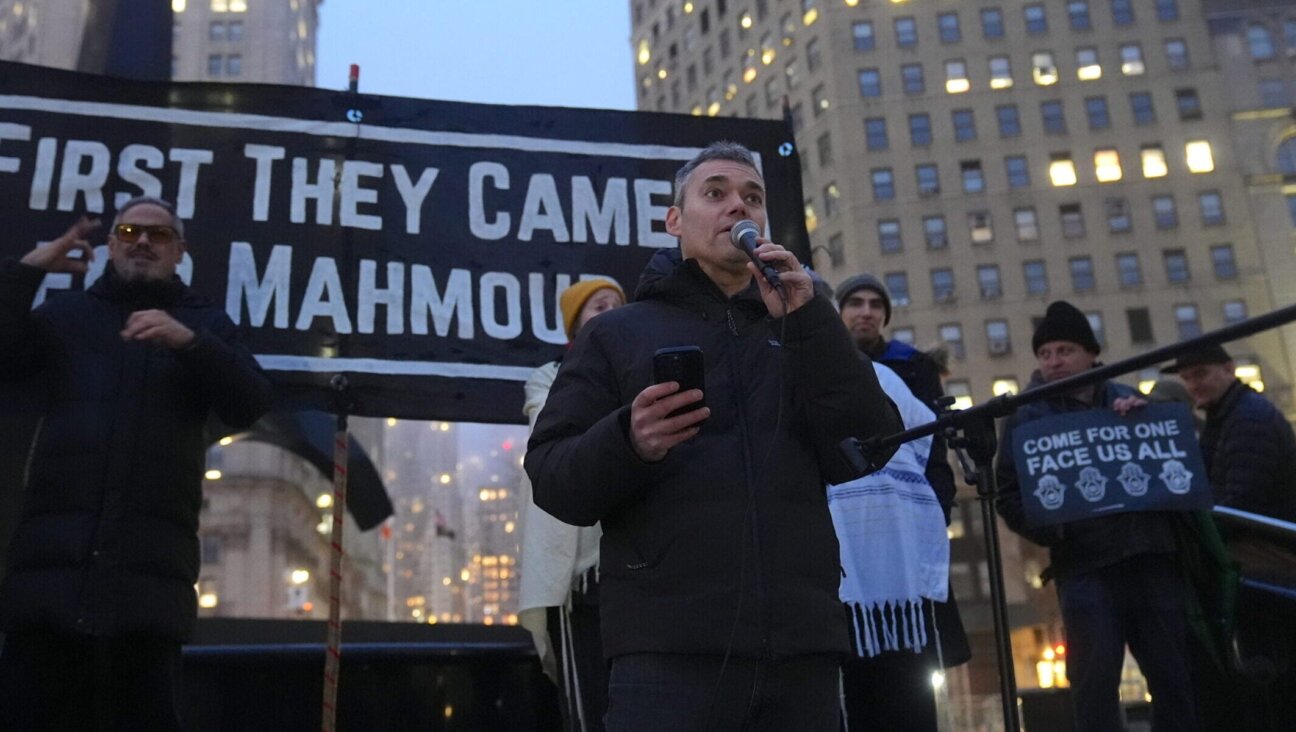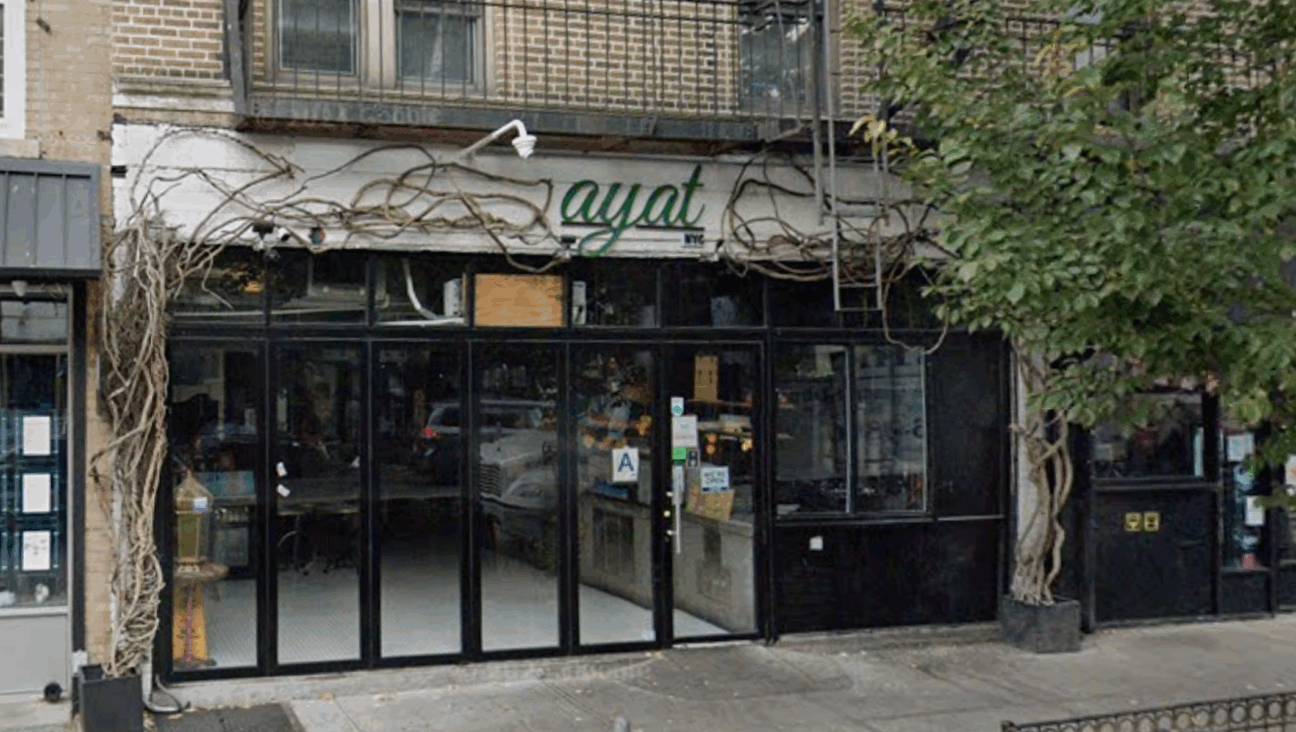The Associated Press Defends Itself Against Nazi Allegations

Adolf Hitler (center). Image by Getty
(Editor’s note: This is an updated post to The Forward’s original publication of a JTA story about the Associated Press and its use of photos supplied by Nazi propagandists.)
The Associated Press has issued a full-throated defense against a historian’s accusations that its photographers worked closely with Adolf Hitler’s regime during World War II.
The academic, Harriet Scharnberg, recently lobbed allegations that the New York-based news service essentially made a deal with the devil, promising the Germans it would not publish any material “calculated to weaken the strength of the Reich abroad or at home.”
AP argues that once its Berlin bureau chief, Louis P. Lochner, winner of a 1939 Pulitzer, was expelled, it was under Third Reich control.
It also admitted, through spokesman Paul Colford, that it had not known some of its photos were produced by the Nazi-controlled agency that emerged post-Lochner.
“Until Ms. Scharnberg’s research (the AP) had no knowledge of any accusation that material may have been directly produced and selected by Nazi propaganda ministries. If it had been, we believe that the captions and photo credits would have made that clear.”
THIS IS THE FULL AP STATEMENT:
In February 2015, historian Harriet Scharnberg sought information from The Associated Press as part of her research and AP shared with her a large amount of material from its Corporate Archives, including oral histories done by World War II era employees.
Her recently published report, based also on other source material outside AP, describes both individuals and their activities before and during the war that were unknown to AP.
As a result, AP has been reviewing documents and other files in and beyond AP Corporate Archives, in the U.S. and Europe, to further our understanding of the period.
AP rejects the suggestion that it collaborated with the Nazi regime at any time. Rather, the AP was subjected to pressure from the Nazi regime from the period of Hitler’s coming to power in 1933 until the AP’s expulsion from Germany in 1941. AP staff resisted the pressure while doing its best to gather accurate, vital and objective news for the world in a dark and dangerous time._ AP news reporting in the 1930s helped to warn the world of the Nazi menace. AP’s Berlin bureau chief, Louis P. Lochner, won the 1939 Pulitzer Prize for his dispatches from Berlin about the Nazi regime. Earlier, Lochner also resisted anti-Semitic pressure to fire AP’s Jewish employees and when that failed he arranged for them to become employed by AP outside of Germany, likely saving their lives.
Lochner himself was interned in Germany for five months after the United States entered the war and was later released in a prisoner exchange. He then spent the next year publicly speaking out against fascism in lectures and in his book, “What about Germany.” Another American AP correspondent, Joe Morton, was executed by the Nazis at the Mauthausen-Gusen concentration camp in 1945 after having been captured when accompanying an OSS mission in 1944. After Lochner’s expulsion, the remnants of the AP bureau, including its physical premises and AP’s photographic archives, effectively were under full Nazi control and possession. The historical research of Ms. Scharnberg concerns a German photo agency subsidiary of AP Britain that was created in 1931, two years before the Nazis came to power. As of 1935, this subsidiary operation became subject to the Nazi press-control law but continued to gather photo images inside Germany and later inside countries occupied by Germany.
U.S. newspapers were supplied with some of these images through the German subsidiary. Those that came from Nazi government, government-controlled or government–censored sources were labeled as such in their captions or photo credits sent to U.S. members and other customers of the AP, who used their own editorial judgment about whether to publish the images.
Images of that time from Germany had legitimate news value as editors and the public needed to learn more about the Nazis. The AP did not engage in direct publication and until Ms. Scharnberg’s research had no knowledge of any accusation that material may have been directly produced and selected by Nazi propaganda ministries. If it had been, we believe that the captions and photo credits would have made that clear.
It is important to note that after Dec. 11, 1941, when Germany declared war on the United States and expelled all foreign news organizations, AP lost control over its subsidiary and therefore the use of its photos. It was left to the former German staff, who stayed on at great risk, to protect the physical archive from outright seizure by the Nazi regime.
Founded in 1846, AP was and is a not-for-profit cooperative. The acquisition of images from inside Germany was part of its general mission of gathering news for AP members and clients, and not for financial gain.
(Editor’s note: Below is The Forward’s original coverage of accusations that America’s leading news wire service was too friendly with the Third Reich)
Was The Vaunted AP Really In Bed With Adolf Hitler?
The Associated Press formally cooperated with Hitler’s Nazi regime, including providing material produced by the Nazi’s propaganda ministry, a German historian reports in a new study.
The AP was the only international news agency allowed to continue to operate in Germany, until the United States entered World War II in 1941.
Historian Harriet Scharnberg, in an article published in German in the academic journal Studies in Contemporary History, shows that AP was able to remain in Germany due to its two-way cooperation with the Nazi regime.
The article was first reported in
The AP agreed to abide by the “Schriftleitergesetz,” or “Editor’s Law,” under which it agreed not to publish any material “calculated to weaken the strength of the Reich abroad or at home.”
Among other alleged cooperations, the AP hired reporters and photographers who also worked for the Nazi propaganda ministry.
The news service also allegedly allowed the Nazis to use its photo archives to create anti-Semitic propaganda.
Scharnberg, a historian at Halle’s Martin Luther University, argued that AP’s cooperation with the Hitler regime allowed the Nazis to “portray a war of extermination as a conventional war,” according to The Guardian.
The study calls into question the AP’s current relationship with totalitarian regimes. For example, according to The Guardian, North Korea, questions have repeatedly been raised about the neutrality of its bureau there.
“As we continue to research this matter, AP rejects any notion that it deliberately ‘collaborated’ with the Nazi regime. An accurate characterization is that the AP and other foreign news organizations were subjected to intense pressure from the Nazi regime from the year of Hitler’s coming to power in 1932 until the AP’s expulsion from Germany in 1941. AP management resisted the pressure while working to gather accurate, vital and objective news in a dark and dangerous time,” an AP spokesman told The Guardian.
















